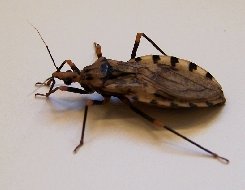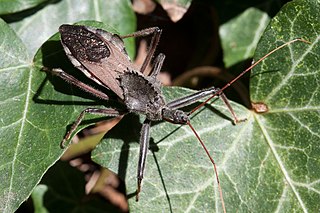
The Reduviidae is a large cosmopolitan family of the suborder Heteroptera of the order Hemiptera. Among the Hemiptera and together with the Nabidae almost all species are terrestrial ambush predators; most other predatory Hemiptera are aquatic. The main examples of nonpredatory Reduviidae are some blood-sucking ectoparasites in the subfamily Triatominae. Though spectacular exceptions are known, most members of the family are fairly easily recognizable; they have a relatively narrow neck, sturdy build, and a formidable curved proboscis. Large specimens should be handled with caution, if at all, because they sometimes defend themselves with a very painful stab from the proboscis.

The members of the Triatominae, a subfamily of the Reduviidae, are also known as conenose bugs, kissing bugs, or vampire bugs. Other local names for them used in the Americas include barbeiros, vinchucas, pitos, chipos and chinches. Most of the 130 or more species of this subfamily feed on vertebrate blood; a very small portion of species feed on invertebrates. They are mainly found and widespread in the Americas, with a few species present in Asia and Africa. These bugs usually share shelter with nesting vertebrates, from which they suck blood. In areas where Chagas disease occurs, all triatomine species are potential vectors of the Chagas disease parasite Trypanosoma cruzi, but only those species that are well adapted to living with humans are considered important vectors. Also, proteins released from their bites have been known to induce anaphylaxis in sensitive and sensitized individuals.

Arilus, or wheel bugs due to the semicircular crest on the pronotum, is a genus of true bugs in the family Reduviidae, subfamily Harpactorinae and tribe Harpactorini. Most species are found in the Americas. Arilus is a generalist predator of insects.

Insects in the subfamily Phymatinae are commonly called ambush bugs after their habit of lying in wait for prey, relying on their superb camouflage. Armed with raptorial forelegs, ambush bugs routinely capture prey ten or more times their own size. They form a subgroup within the assassin bugs.

The Harpactorinae are a large subfamily of the Reduviidae. About 300 genera and 2,000 species worldwide have been described. Some of the species of the genera Zelus, Pselliopus, Sinea, and Apiomerus are of interest as biological pest control agents.

Barce is a genus of thread-legged bugs in the family Reduviidae. There are about six described species in Barce.
Acholla multispinosa is a species of assassin bug in the family Reduviidae. It is found in North America.

Rhiginia cruciata, commonly known as the scarlet-bordered assassin bug or cruciate assassin bug, is a species of millipede assassin in the family Reduviidae. It is found in the Caribbean, Central America, and North America.

Fitchia aptera is a species of assassin bug in the family Reduviidae. It is found in North America.
Ghinallelia productilis is a species of thread-legged bug in the family Reduviidae. It is found in the Caribbean and North America.
Ghinallelia is a genus of thread-legged bugs in the family Reduviidae. There are at least 2 described species in Ghinallelia.

Fitchia is a genus of assassin bugs in the family Reduviidae. There are at least two described species in Fitchia.

Atrachelus is a genus of assassin bugs in the family Reduviidae, found in the Americas. There are at least two described species in Atrachelus.
Empicoris orthoneuron is a species of thread-legged bug in the family Reduviidae. It is found in Central America, North America, and South America.
Acholla is a genus of assassin bugs in the family Reduviidae. There are at least three described species in Acholla, found in North America.

Empicoris rubromaculatus, the thread bug, is a species of thread-legged bug in the family Reduviidae. It is found in North America and Oceania.
Empicoris errabundus is a species of thread-legged bug in the family Reduviidae. It is found in the Caribbean, Central America, and North America.
Empicoris winnemana is a species of thread-legged bug in the family Reduviidae. It is found in North America.
Rhynocoris marginatus is a species of assassin bug in the family Reduviidae. It is a predator of other insects and is found in Asia. Crops in India on which it has been found feeding on pests include sugarcane, pigeon pea, cardamom, cotton, tea, and peanuts. The insects are potentially useful in biological control because they are more resistant to pesticides than are the pests on which they feed.
Fitchia is the scientific name of two genera of organisms and may refer to:








